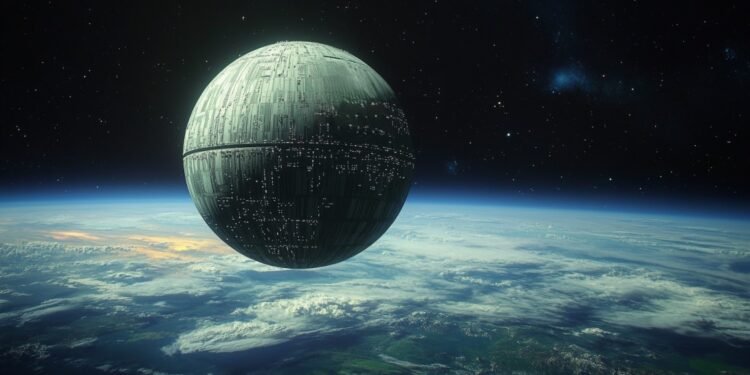In the book The Etheric Crystal by Radu Cinamar,we learn that the Moon, Earth’s natural satellite, is not just a simple celestial body but an artificial structure of immense proportions. According to the book, the Moon is an ancient spacecraft constructed millions of years ago by an extraterrestrial civilization that is highly advanced in both technological and spiritual terms. The book details how this spacecraft, which conceals technologies unknown to modern humanity, played a crucial role in influencing life and Earth’s energetic balance. The author indicates that this mysterious civilization used the Moon not only as a means of interstellar exploration but also as an instrument to support the development of life on our planet, thereby creating a profound and enigmatic connection between Earth and its satellite.

The Emergence and Evolution of the Ancient Sirian Civilization
The Origin of the Civilization
Approximately 98 million years ago, in the star Sirius A’s planetary system, a humanoid civilization was technologically advanced enough to undertake interstellar travel with massive spacecraft. This civilization had impressive control over the laws governing space and time. However, the members of this civilization were not the Sirians we know today but their distant precursors, who evolved and transformed over time.
Physical and Cultural Characteristics
These beings bore similarities to humans but exhibited notable differences: their average height ranged between 1.90 and 2 meters, their skin was pearlescent white with a bluish tint, their hair was predominantly black with blue highlights, their eyes were larger than those of modern humans, and their mouths were smaller. These ancestors had a deep understanding of their native constellation, Canis Majoris, and the constellation Orion, where they established colonies that eventually became distinct and evolved through hybridization with other extraterrestrial races.
Connection to Earth and the Terraforming Process
Earth as a “Soul Planet”
The ancient Sirians regarded Earth as a “soul planet” and decided to gradually transform it into a suitable habitat for life. This plan involved terraforming over an extended period, allowing the biosphere to develop naturally and sustainably.
The Initial State of Earth
About 65 million years ago, Earth was dominated by conifer forests, giant ferns, and enormous cacti. The dense atmosphere contained high levels of carbon dioxide and dust, which filtered sunlight, giving the sky a yellow-orange hue. While the terrestrial flora and fauna were abundant, their genetic complexity was limited, prompting the Sirians to intervene and stimulate evolution.
The Sirian Intervention and the Role of the Flagship
The Flagship and the Research Team
The Sirians arrived on Earth with a massive, spherical spacecraft comparable in size to the Moon, aiming to catalyze evolution. The research team, led by Orma, a biologist specializing in “planetary nano-biology,” studied the existing DNA structure and proposed creating a fluctuating force field to stimulate the development of life on Earth.
The Terraforming Process
The terraforming process involved:
- Purifying the atmosphere by removing dust.
- Enriching the atmosphere with oxygen.
- Creating a variable force field to prevent stagnation in evolution.
Orma suggested bringing a massive celestial body to generate the force field and “vacuum” cosmic dust around Earth. Ultimately, the flagship itself was placed in Earth’s orbit.
Transforming the Flagship into Earth’s “Natural” Satellite
Structure and Functions of the Ship
The flagship, later known as the Moon, featured a concentric structure with a hollow center and energy “rays” generating plasma. The complex interior resembled a conglomerate of cities equipped with advanced technologies.
Role in Earth’s Evolution
The ship collected cosmic dust, forming an outer crust, and subtly influenced the biosphere. Once stabilized in orbit, Earth underwent significant changes:
- The atmosphere became more ionized, promoting cloud formation and rainfall.
- Vegetation evolved, and flowering plants emerged for the first time, starting with cacti.
The Impact of Terraforming on Earth’s Biosphere
Influence on Flora and Fauna
The terraforming process led to the emergence of flowers and the diversification of plant and animal life. Cacti were the first to develop flowers, influenced by the Moon’s presence.
Protection Against Cataclysms
The flagship absorbed much of the debris from the explosion of the planet Maldek (or Tiamat), a terrestrial planet located between Jupiter and Mars, preventing significant damage to Earth’s biosphere and ensuring the survival of life forms.
Conclusions
The Moon, now recognized as Earth’s natural satellite, was originally a flagship belonging to the ancient Sirian civilization from the Sirius A system. This advanced civilization’s intervention played a crucial role in shaping Earth’s biosphere, leading to significant transformations in its flora and fauna and laying the groundwork for the development of complex life.
You can find more details in the book The Etheric Crystal, written by Radu Cinamar.
source:
book The Etheric Crystal written by Radu Cinamar







